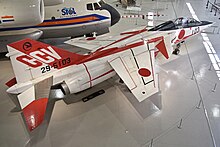Mitsubishi T-2
| Mitsubishi T-2 | |
|---|---|

|
|
| Type: | Supersonic trainer |
| Design country: | |
| Manufacturer: | |
| First flight: |
20th July 1971 |
| Commissioning: |
1975 |
| Number of pieces: |
90 |
The Mitsubishi T-2 is a Japanese training plane that because of the demands of the JASDF for a supersonic - coaches came. What is striking is the similarity to the SEPECAT Jaguar , which was probably the godfather.
history
In the early 1960s, the JASDF were looking for replacements for their aging F-86F Saber for advanced training. The license production of the SEPECAT Jaguar and the import of the Northrop T-38 came into question . For political reasons and to gain experience with supersonic jets , however, an in-house development was favored. In early 1966 the Japanese Defense Agency (now the Ministry of Defense of Japan ) asked the three companies Fuji , Kawasaki and Mitsubishi to submit drafts for the program called TX. On February 8, 1967, Fuji and Mitsubishi presented their designs after Kawasaki had previously withdrawn from the program. On September 5, 1967, the Mitsubishi design was officially selected as the best design and a development group of several companies formed under the direction of Kenji Ikeda , Mitsubishi's chief designer. Mitsubishi was responsible for the front and middle fuselage as well as the final assembly, Fuji took over the stern area and the wings, Nihon Hikoki the external load carriers and Shin Meiwa the additional tanks. Was that used in the Jaguar on 15 February 1968 as a drive Adour - engine selected, the imported after twelve copies from Europe at Ishikawajima-Harima Heavy Industries was produced under license. The first mockup was shown on April 24, 1968, and on March 28, JASDF ordered two prototypes called XT-2s and a cell for stress tests. The first of the prototypes had its maiden flight on July 20, 1971 in Nagoya Airport with Kenshiro Endo and Mitsuo Sato on board. During the 38-minute flight, the aircraft climbed to an altitude of 6,000 m and reached a speed of 851 km / h. On the 30th flight on November 19, 1971, the aircraft was the first Japanese in-house development to reach supersonic speed at Mach 1.03 at an altitude of 9,100 m.
After three more prototypes, which had their maiden flight on December 2, 1971, April 28, 1972 and July 20, 1972, series production quickly followed, as only a few problems were found during testing. For the series, only the spoilers had to be improved in their effectiveness and, due to longitudinal instabilities, the wing root cladding had to be changed. The only serious problem was the cost increase from $ 3.5 million to $ 5 million apiece, which in times of economic crisis and inflation almost led to the program being suspended. On March 31, 1973 the Ministry of Defense ordered 20 machines and on January 21, 1974 Parliament approved the purchase of a further 22 machines, eleven of them as T-2A combat trainers with 20 mm Vulcan M61 cannon as armament. A pure combat version was developed under the designation F-1, which differed from the trainer by a metal cladding of the rear cockpit and additional avionics . On October 1, 1976, the T-2 was declared operational and gradually several squadrons were equipped with the aircraft. On November 14, 1982, a machine of the aerobatic team crashed during a demonstration in Hamamatsu , killing the pilot and injuring twelve spectators. A total of four jets were lost in accidents. Of the 96 aircraft built, 28 T-2 machines were used for advanced training, 62 T-2A for weapon training and two as test vehicles. The two test vehicles then ended up in the Mitsubishi F-1 series machine . The aircraft was gradually replaced from 1995 by the T-4, the F-2B and the F-15. One of them was used from August 1983 as a test vehicle for a fly-by-wire control (T-2 CCV) and equipped with duck wings and a fin under the fuselage. On March 14, 2004, the last machine was taken out of service, with individual machines flying until 2006 in Tsuiki and Gifu at the flight test center for test purposes. In total, the aircraft achieved 307,000 flight hours and 1,450 pilots were trained on the type.
construction
The T-2 was a shoulder- wing aircraft whose fuselage was made in half-shell construction and contained seven fuel tanks with a total capacity of 3820 liters. The wings had a negative V-position of 9 °, had a sawtooth leading edge and no ailerons , but only a large landing flap with two spoilers in front.
Technical specifications
| Parameter | Data |
|---|---|
| crew | 2 |
| length | 17.86 m |
| span | 7.88 m |
| height | 4.39 m |
| Wing area | 21.48 m² |
| Empty mass | 6,307 kg |
| Max. Takeoff mass | 12,900 kg |
| Top speed | 1,700 km / h at an altitude of 11,000 m |
| Service ceiling | 15,240 m |
| Transfer range | 2,595 km (with external tanks) |
| Engines | two Rolls-Royce / Turboméca-Adour-MK-801A engines (license production as Ishikawajima-Harima TF40-IHI-801A) |
| Thrust | with afterburner: 2 × 32.49 kN without afterburner: 2 × 22.75 kN |
Armament
- a 20mm JM61 cannon
- six wing stations for additional weapons (including two launch rails on the wing ends for air-to-air missiles)
See also
Web links
- Vector site: Mitsubishi T-2 / F-1 and Kawasaki T-4
